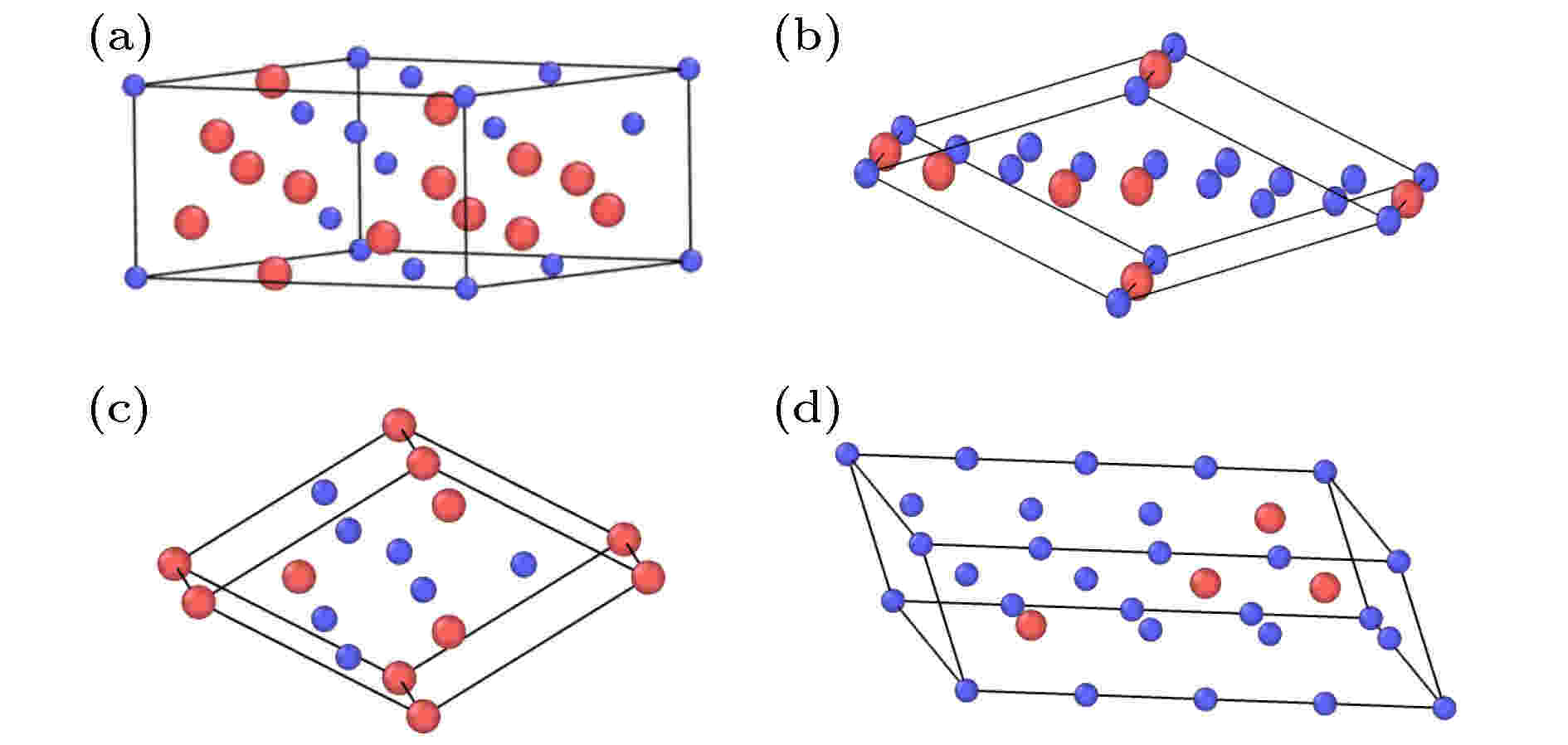全文HTML
--> --> -->实际合金中合金元素浓度在局部区域存在起伏从而引起合金局部性质的涨落, 然而对于合金块体, 由于存在大量的随机局域构型, 因而从整体上来看, 合金的物理性能是大量局域构型物理性能的统计平均. 因此针对随机置换固溶体合金的计算模拟思路可包括, 研究大量的随机构型的小尺寸超胞, 然后进行统计平均, 或者构建尺寸较大的超胞进行研究. 分子动力学模拟用超胞中原子数目可以达到上百万个, 因而可以通过用溶质原子随机取代溶剂原子的方式来模拟真实随机置换固溶体中的原子分布, 按这种方式得到的结构叫做随机取代结构(random substitution structure, RSS); 而FP计算量大, 使用的体系大小有限, 因此Wei等[9]提出了SQS (special quasirandom structure)模型. 在SQS模型中, 通过调整一定成分的小超胞中各原子的排列方式, 以使得一定距离范围内(比如前四近邻)的对关联函数与实际晶体尽可能接近, 从而实现小超胞模拟随机固溶体合金体系. 前期FP计算[10,11]表明小尺寸SQS超胞能够获得部分与实验结果接近的物理性能, 因此Hu等[12]将SQS模型用于高熵合金的研究. 但含有特定成分的SQS超胞往往仅对应一种构型, 其模拟结果与分子动力学通过随机取代结构模型得到的多构型统计平均值的相似性还有待进一步深入研究. 因此, 本文针对Zr-Nb合金, 运用分子动力学方法对小尺寸SQS超胞模拟随机置换固溶体合金的可行性进行了研究. 首先, 确定了能真实反映固溶体合金物理性能统计性的RSS模型超胞的临界尺寸; 然后比较了两种模型获得的Zr-Nb合金的晶格常数、形成能和能量-体积关系. 研究表明, 利用SQS超胞得到的合金的物理性能与利用一系列RSS超胞得到的对应统计值接近, 因而SQS超胞可用于研究随机置换固溶体合金.
本文的第2部分给出了分子动力学模拟所使用的势函数和具体的模拟细节. 第3部分是结果与讨论, 包括RSS模型超胞临界尺寸的确定、Zr-Nb合金晶格常数、形成能和能量-体积关系的研究, 以及SQS模型与RSS模型结果差异的分析讨论. 最后是全文的结论.
2.1.Zr-Nb势函数
势函数是MD计算的关键. 金属中常用嵌入原子法(EAM)[13]来描述原子间的相互作用. 在EAM势函数中, N个原子构成的系统总能量(Etotal)可以表示为


针对Zr-Zr和Nb-Nb的势函数, 采用Wadley的EAM势[14,15], 对势V(rij)和电子密度



嵌入能为



关于Zr-Nb对势

2
2.2.模拟细节
本文分别针对hcp结构超胞和bcc结构超胞进行了模拟. bcc结构超胞的x, y和z轴分别为[100], [010]和[001]晶向; hcp结构超胞的x, y和z轴分别为

以bcc结构为例说明确定RSS超胞临界尺寸的方法: 首先构建了6 × 6 × 6, 8 × 8 × 8, 10 × 10 × 10和20 × 20 × 20四种尺寸的超胞, 分别含有432, 1024, 2000和16000个原子; 为了研究的系统性, 对每一种尺寸下的每一种浓度(10%—90%, 以10%为间隔, 共9种浓度), 分别构造50组不同的RSS超胞进行模拟, 不同浓度合金的初始晶格常数通过Vegard定律估算获得. 该定律指出, 当组成相的键合性质相似时, 连续置换固溶体的晶体学参数在恒温条件下随浓度线性变化[20].
对于hcp结构超胞的临界尺寸研究, 除了所用的超胞尺寸(分别为5 × 5 × 5, 10 × 5 × 5, 10 × 10 × 10和20 × 20 × 20)与bcc结构略有不同外, 其构型误差的研究过程与bcc结构相同, 此处不再赘述.
本文所用的SQS超胞是将初始SQS超胞沿3个晶格矢量方向扩展后得到的. SQS超胞中原子的排列方式受到晶体结构、合金元素成分以及超胞尺寸的影响. 对于

 图 1
图 1 
Figure1. Supercells of the

3.1.RSS超胞临界尺寸
如前文所述, 在随机置换固溶体合金中, 每一个原子附近其他原子的排布方式(配位情况)是随机的, 真实合金中包含有大量的这种排布方式, 因而固溶体合金性质是大量的这种微观排布的统计平均. 如果要反映固溶体物理性能的这种统计性, 模拟用的超胞就需要足够大的尺寸, 但为了保证计算的效率与速度, 又不宜采用太大的超胞. 因此, 必须确定能兼顾这两个因素的RSS超胞的临界尺寸.在确定RSS超胞临界尺寸时, 本文的判断依据是不同构型合金形成能相对误差, 即构型误差. 模拟时出现构型误差是因为RSS模型在随机取代溶剂原子时, 会得到不同的原子构型(原子的不同配位和这些局域构型不同排列方式), 在小尺寸超胞模拟中, 固溶体性质可能存在较大的涨落. 本文中构型误差定义如下:






不同尺寸超胞中的形成能误差如图2所示, 这里应该指出的是, 图中的构型误差是9种浓度下分别计算的构型误差的算术平均值(

 图 2 不同超胞尺寸的bcc和hcp结构Zr-Nb合金的构型误差(形成能的相对误差)
图 2 不同超胞尺寸的bcc和hcp结构Zr-Nb合金的构型误差(形成能的相对误差)Figure2. Configuration Errors of Zr-Nb alloy with bcc and hcp structure in different supercell sizes (relative errors of formation energy).
2
3.2.SQS超胞的分子动力学模拟
类似于RSS模型的超胞, 我们将SQS模型小尺寸超胞扩展成大于临界尺寸的超胞, 然后对这些超胞进行了分子动力学模拟, 得到了固溶体合金的晶格常数、形成能以及能量-体积曲线, 并与50种不同构型的RSS超胞的统计平均值进行比较分析.3
3.2.1.晶格常数
晶格常数是晶体物质的基本结构参数, 晶格常数的变化通常反映了晶体内部的成分、受力状态等的变化. 平衡晶格常数对应于体系能量最小时的晶格常数, 本节通过调整晶格常数找到合金的最低能量, 从而确定对应浓度合金的平衡晶格常数. bcc结构的Zr-60%Nb合金的体系能量与晶格常数变化如图3所示, 可以看到晶格产生在3.41 ?时, 能量最低, 因而确定该合金的晶格常数为3.41 ?. 采用该方法确定了SQS超胞和RSS超胞在各个浓度下的平衡晶格常数, 结果如图4所示, 图中还比较了Smirnova和Starikov[2]采用ADP (angular-dependent potential)势计算得到的合金晶格常数. 图 3 bcc结构Zr-60%Nb合金能量与晶格常数的关系
图 3 bcc结构Zr-60%Nb合金能量与晶格常数的关系Figure3. Relationship between solid solution energy and lattice constant of Zr-60%Nb alloy in bcc lattice.
 图 4 由SQS和RSS模型得到的合金晶格常数与Nb浓度的关系 (a) bcc晶格; (b) hcp晶格; (a)中实验值取自文献[22, 23], ADP势函数计算的晶格常数取自Smirnova和Starikov[2]
图 4 由SQS和RSS模型得到的合金晶格常数与Nb浓度的关系 (a) bcc晶格; (b) hcp晶格; (a)中实验值取自文献[22, 23], ADP势函数计算的晶格常数取自Smirnova和Starikov[2]Figure4. Relationships between the alloy lattice constant and Nb concentration obtained from SQS and RSS models: (a) The bcc lattice; (b) the hcp lattice. In Fig. 4(a), the experimental values were obtained from literatures[22,23], and the lattice constant calculated from the ADP potential function was taken from Smirnova and Starikov[2].
图4(a)展示的是bcc结构Zr-Nb合金的晶格常数, 可以看到, SQS超胞和RSS超胞得到的平衡晶格常数接近, 差异较小; 而且从图4(a)还可以看到, 随着Nb原子浓度的增加, 合金平衡晶格常数线性减小, 与实验值[22,23]和Vegard定律预测值接近, 但Smirnova和Starikov[2]拟合的ADP势函数计算获得的晶格常数偏大. 图4(b)展示的是hcp结构Zr-Nb合金的晶格常数, 同样可以看到, SQS超胞和RSS超胞得到的平衡晶格常数接近, 但相对于bcc结构, hcp结构中两种模型的差异偏大. 应该指出的是, 在计算过程发现当Nb原子浓度超过40%时, 合金能量与晶格常数不是单调递增或递减关系, 而是出现了能量起伏, 因而不能使用上述方法来确定平衡晶胞参数. 另外, 由于核材料领域中hcp晶格Zr-Nb合金的Nb原子比例通常都低于10%[22,24], 因而图4(b)仅展示了Nb原子比例0—50%的结果.
3
3.2.2.随机固溶体形成能
形成能是表征合金原子合金化(

 图 5 SQS模型与RSS模型计算的Zr-Nb合金的总形成能 (a) bcc晶格; (b) hcp晶格
图 5 SQS模型与RSS模型计算的Zr-Nb合金的总形成能 (a) bcc晶格; (b) hcp晶格Figure5. Total formation energies of Zr-Nb alloy calculated from the RSS and SQS structures: (a) The bcc lattice; (b) the hcp lattice.
从图5(a)可以看到bcc结构的Zr-Nb随机置换固溶体的形成能都是正值, 表明易产生偏析现象, 这与Zr-Nb相图[26]中在10%—90%Nb原子浓度范围内, 温度低于400 ℃时, 合金均为α-Zr与β-Nb两相共存的现象相一致. 我们还发现, 随着Nb原子浓度的增加, 固溶体形成能先增大后减小, 说明在富Zr和富Nb的固溶体中, 合金偏析能力有所下降. 另外可以看到SQS模型与RSS模型的总形成能在25%, 50%, 75% 三个浓度处接近, 且两者样条插值曲线也基本重合, 表明两者对bcc晶格Zr-Nb固溶体的形成能描述是基本一致的. 但是两个模型给出的形成能仍存在细微差异, 比如在25%和75%浓度处, SQS超胞和RSS超胞的形成能差值在0.3 kJ/mol左右, 大于RSS模型的统计误差(图5(a)中已标出了RSS模型的误差棒, ~10–2 kJ/mol).
与晶格常数部分类似, 图5(b)仅显示了Nb原子浓度在0—50%范围内hcp结构Zr-Nb合金的总形成能, 可以看到SQS模型与RSS模型的总形成能基本接近, 随着Nb浓度的升高, 形成能也随之增大, 且均为正值, 这与bcc晶格趋势类似. 同样两种模型仍存在差异, 对于25%Nb, 形成能差异约为1 kJ/mol (大于RSS模型统计误差 ~0.01 kJ/mol); 对于50%Nb, 形成能差异约为2 kJ/mol (大于RSS超胞误差0.3 kJ/mol). 对比图5(a)可知, hcp结构的两种模型的形成能差异要大于bcc晶格的形成能差异, 其原因可能是, 本文使用的hcp晶格SQS超胞, 构造时仅拟合前四(

3
3.2.3.能量-体积曲线
晶格常数和总形成能是固溶体合金的平衡态性质, 而能量-体积(E-V )关系可以给出体系在远离平衡态(如: 压缩或膨胀)时的性质. E-V关系可用Rose等[27]提出的状态方程(EOS)来描述:通过分子动力学模拟得到的SQS模型和RSS模型的E-V关系曲线如图6(bcc晶格)和图7(hcp晶格)所示. 从图6和图7可以看到, EOS方程能较好地描述Zr-Nb随机置换固溶体的E-V关系. SQS模型和RSS模型的E-V关系曲线几乎完全重合, 固溶体能量随着Nb浓度的增大而降低. 由于势函数的不同, Smirnova和Starikov[2]的E-V曲线与相应随机置换固溶体合金的E-V关系明显偏离. 需要指出的是, 图中Smirnova和Starikov的E-V曲线(由ADP势函数计算获得)对应的是金属化合物L12和B2, 而非随机置换固溶体.
 图 6 bcc晶格RSS超胞和SQS超胞的E-V曲线, 以及ADP势的计算结果, 其中, 多边形和圆形图标为对应的SQS和RSS模型的能量计算值, 对应的曲线是用EOS方程[27]拟合得到的E-V曲线; 单点划线、双点划线和短划线是Smirnova和Starikov[2]得到的ADP势模拟结果
图 6 bcc晶格RSS超胞和SQS超胞的E-V曲线, 以及ADP势的计算结果, 其中, 多边形和圆形图标为对应的SQS和RSS模型的能量计算值, 对应的曲线是用EOS方程[27]拟合得到的E-V曲线; 单点划线、双点划线和短划线是Smirnova和Starikov[2]得到的ADP势模拟结果Figure6. Energy-volume curves of RSS and SQS supercells in bcc lattice, and the calculation results of ADP potential. The polygon and circular icons are the energy calculation values of the corresponding SQS and RSS structure, and the corresponding curves are the E-V curves obtained by fitting EOS equation[27]. Single dotted line, double dotted line and short dotted line are the calculated results of ADP potential obtained by Smirnova and Starikov[2].
 图 7 hcp晶格SQS超胞和RSS超胞的Zr-25%Nb合金E-V曲线, 以及ADP势的计算结果[2]
图 7 hcp晶格SQS超胞和RSS超胞的Zr-25%Nb合金E-V曲线, 以及ADP势的计算结果[2]Figure7. E-V curves of Zr-25%Nb alloy obtained by SQS supercells and RSS supercells in hcp lattice, and the calculation results of ADP potential[2].
通过拟合Rose状态方程, 可获得材料的平衡性质, 包括晶胞参数、结合能和体弹性模量, 拟合结果如表1所列. 另外表1中还列出文献[17]中拟合数据. 可以看到, SQS超胞和RSS超胞得到的结合能差异均小于0.01 eV (远小于不同势函数之间的能量差), 体弹模量的差异也都在4 GPa以下, 证明两种超胞的模拟结果是十分一致的. 因此可以认为, 两种模型对固溶体非平衡态E-V关系的模拟是一致的.
| Alloy | a/? | c/? | Ec/(eV·atom–1) | B0/GPa |
| Zr0.75Nb0.25(bcc) | 3.527 | 6.450 | 96 | |
| 3.531 | 6.447 | 100 | ||
| Zr0.75Nb0.25(hcp) | 3.200 | 5.097 | 6.468 | 144 |
| 3.202 | 5.100 | 6.477 | 142 | |
| *L12-Zr3Nb | 4.49 | 6.45 | 107 | |
| Zr0.5Nb0.5(bcc) | 3.442 | 6.745 | 118 | |
| 3.441 | 6.744 | 117 | ||
| *B2-ZrNb | 3.48 | 6.69 | 116 | |
| Zr0.25Nb0.75(bcc) | 3.366 | 7.127 | 153 | |
| 3.367 | 7.124 | 156 | ||
| *L12-ZrNb3 | 4.34 | 6.96 | 100 |
表1由EOS方程拟合得到的Zr-Nb合金性质(带“*”的为文献[17]的拟合结果; 第一行对应RSS超胞, 第二行对应SQS超胞)
Table1.Properties of Zr-Nb alloy obtained by fitting EOS equation, and the “ * ” is the fitting result of literature[17]. The first line corresponds RSS structure, and the second line corresponds SQS structure.
为了使RSS模型既能准确体现固溶体物理性质统计性的同时又能保证计算速度, 首先确定了RSS超胞的临界尺寸, 然后分别将SQS模型超胞和RSS模型超胞用于分子动力学模拟, 并给出了两种模型在不同Nb原子浓度下的晶格常数、合金形成能以及能量-体积曲线. 模拟结果表明, 无论是平衡态的晶格常数、形成能, 还是非平衡态的能量-体积曲线, SQS模型的模拟结果与RSS模型的统计平均值相比, 虽然有细微的差别, 但在数值上都十分接近, 表明利用小尺寸SQS超胞模拟随机置换固溶体的方法是可靠的. 因此, 对于二元随机置换固溶体的模拟, 在分子动力学势函数开发难度很大的情况下, 可以利用SQS模型进行第一性原理计算, 并为MD势函数开发提供重要的物理性质.
